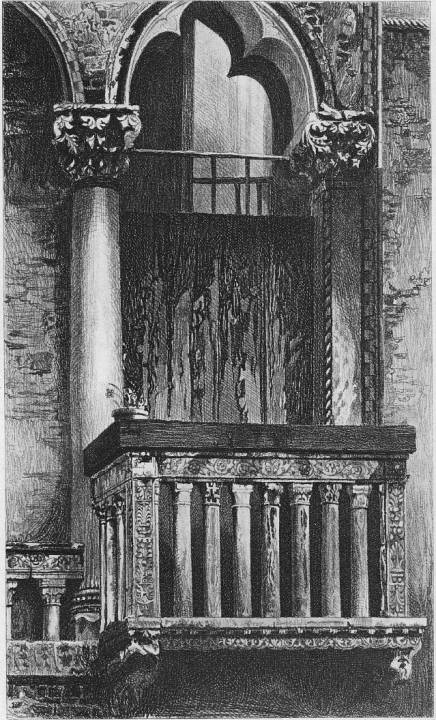Window in the Campo St. Benedetto, Venice, by John Ruskin (original) (raw)

Window in the Campo St. Benedetto, Venice
John Ruskin
R. P. Cuff, engraver
1855
7 3/16 x 4 5/32 inches
Plate XI, The Seven Lamps of Architecture in Works, 8.175
According to the "Index to the Plates" (8.xvi), Ruskin discusses this plate on the page quoted below.
Scanned image and text by George P. Landow
[You may use this image without prior permission for any scholarly or educational purpose as long as you (1) credit the photographer and (2) link your document to this URL]
“The Lamp of Beauty”
Never imitate anything but natural forms, and those the noblest, in the completed parts. The degradation of the cinque cento manner of decoration was not owing to its naturalism, to its faithfulness of imitation, but to its imitation of ugly, i.e. unnatural things. So long as it restrained itself to sculpture of animals and flowers, it remained noble. The balcony, on the opposite page (Plate XI.), from a house in the Campo St. Benedetto at Venice, shows one of the earliest occurrences of the cinque cento arabesque, and a fragment of the pattern is given in Plate XII. fig. 8. It is but the arresting upon the stone work of a stem or two of the living flowers, which are rarely wanting in the window above (and which, by the by, the French and Italian peasantry often trellis with exquisite taste about their casements). This arabesque, relieved as it is in darkness from the white stone by the stain of time, is surely both beautiful and pure ; and as long as the renaissance ornament remained in such forms it may be beheld with unreserved admiration. [p. 175]
Bibliography
Ruskin, John. Works, "The Library Edition." eds. E. T. Cook and Alexander Wedderburn. 39 vols. London: George Allen, 1903-1912.
Ruskin, John. The Seven Lamps of Architecture in Works, vol. 8. Hathi Trust Digital Library. Web. 6 June 2010.
Last modified 6 June 2010